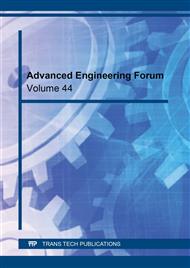[1]
H.J. Peng, J.Q. Huang, X.B. Cheng and Q. Zhang, Review on high-loading and high-energy lithium-sulfur batteries, Adv. Energy Mater. 7 (2017) 1700260.
DOI: 10.1002/aenm.201700260
Google Scholar
[2]
Y.X. Yin, S. Xin, Y.G. Guo and L.J. Wan, Lithium-sulfur batteries: electrochemistry, materials, and prospects, Angew. Chemie Int. Ed. 52 (2013) 13186.
DOI: 10.1002/anie.201304762
Google Scholar
[3]
R.P. Fang, S.Y. Zhao, Z.H. Sun, D.W. Wang, H.M. Cheng and F. Li, More reliable lithium-sulfur batteries: status, solutions and prospects, Adv. Mater. 29 (2017) 1606823.
DOI: 10.1002/adma.201606823
Google Scholar
[4]
X.Q. Zhang, C. Liu, Y. Gao, J.M. Zhang and Y.Q. Wang, Research progress of sulfur/carbon composite cathode materials and the corresponding safe electrolytes for advanced Li-S batteries, Nano 15 (2020) 2030002.
DOI: 10.1142/s1793292020300029
Google Scholar
[5]
J. Xu, T. Lawson, H. Fan, D. Su and G. Wang, Updated metal compounds (MOFs, -S, -OH, -N, -C) used as cathode materials for lithium-sulfur batteries, Adv. Energy Mater. 8 (2018) 1702607.
DOI: 10.1002/aenm.201702607
Google Scholar
[6]
X. Xiong, W. Yan, C. You, Y. Zhu, Y. Chen, L. Fu, Y. Zhang, N. Yu and Y. Wu, Methods to improve lithium metal anode for Li-S batteries, Front. Chem. 7 (2019) 827.
DOI: 10.3389/fchem.2019.00827
Google Scholar
[7]
W. Chen, T. Lei, C. Wu, M. Deng, C. Gong, K. Hu, Y. Ma, L. Dai, W. Lv, W. He, X. Liu, J. Xiong and C. Yan, Designing safe electrolyte systems for a high-stability lithium-sulfur battery, Adv. Energy Mater. 8 (2018) 1702348.
DOI: 10.1002/aenm.201702348
Google Scholar
[8]
Y. He, Y. Qiao and H. Zhou, Recent advances in functional modification of separators in lithium–sulfur batteries, Dalton Trans. 47 (2018) 6881.
DOI: 10.1039/c7dt04717g
Google Scholar
[9]
X. Ji, K.T. Lee and L.F. Nazar, A highly ordered nanostructured carbon-sulphur cathode for lithium-sulphur batteries, Nat. Mater. 8 (2009) 500.
DOI: 10.1038/nmat2460
Google Scholar
[10]
H. Wang, Y. Yang, Y. Liang, J.T. Robinson, Y. Li, A. Jackson, Y. Cui and H. Dai, Graphene-wrapped sulfur particles as a rechargeable lithium-sulfur battery cathode material with high capacity and cycling stability, Nano Lett. 11 (2011) 2644.
DOI: 10.1021/nl200658a
Google Scholar
[11]
S. Evers and L.F. Nazar, Graphene-enveloped sulfur in a one pot reaction: a cathode with good coulombic efficiency and high practical sulfur content, Chem. Commun. 48 (2012) 1233.
DOI: 10.1039/c2cc16726c
Google Scholar
[12]
M. Shaibani, A. Akbari, P. Sheath, C.D. Easton, P.C. Banerjee, K. Konstas, A. Fakhfouri, M. Barghamadi, M.M. Musameh, A.S. Best, T. Rüther, P.J. Mahon, M.R. Hill, A.F. Hollenkamp and M. Majumder, Suppressed polysulfide crossover in Li-S batteries through a high-flux graphene oxide membrane supported on a sulfur cathode, ACS Nano 10 (2016) 7768.
DOI: 10.1021/acsnano.6b03285
Google Scholar
[13]
J.L. Gómez-Urbano, J.L. Gómez-Cámer, C. Botas, N. Díez, J.M. López del Amo, L.M. Rodríguez-Martinez, D. Carriazo and T. Rojo, Hydrothermally reduced graphene oxide for the effective wrapping of sulfur particles showing long term stability as electrodes for Li-S batteries, Carbon N. Y. 139 (2018) 226.
DOI: 10.1016/j.carbon.2018.06.053
Google Scholar
[14]
K. Urita, T. Fujimori, H. Notohara and I. Moriguchi, Direct observation of electrochemical lithium–sulfur reaction inside carbon nanotubes, ACS Appl. Energy Mater. 1 (2018) 807.
DOI: 10.1021/acsaem.7b00258
Google Scholar
[15]
X.Q. Zhang, B. He, W.C. Li and A.H. Lu, Hollow carbon nanofibers with dynamic adjustable pore sizes and closed ends as hosts for high-rate lithium-sulfur battery cathodes, Nano Res. 11 (2018) 1238.
DOI: 10.1007/s12274-017-1737-6
Google Scholar
[16]
J. Yao, G.X. Wang, J. Ahn, H. K. Liu and S.X. Dou, Electrochemical studies of graphitized mesocarbon microbeads as an anode in lithium-ion cells, Journal of Power Sources 114 (2003) 292.
DOI: 10.1016/s0378-7753(02)00585-2
Google Scholar
[17]
Q. Jin, X. Qi, F. Yang, R. Jiang, Y. Xie, L. Qie and Y. Huang, The failure mechanism of lithium-sulfur batteries under lean-ether-electrolyte conditions, Energy Storage Materials 38 (2021) 255.
DOI: 10.1016/j.ensm.2021.03.014
Google Scholar
[18]
Y. Xie, G. Pan, Q. Jin, X. Qi, T. Wang, W. Li, H. Xu, Y. Zheng, S. Li, L. Qie, Y. Huang and J. Li, Semi‐flooded culfur cathode with ultralean absorbed electrolyte in Li–S battery, Adv. Sci. 7 (2020) 1903168.
DOI: 10.1002/advs.201903168
Google Scholar
[19]
M. Zhao, B.Q. Li, H.J. Peng, H. Yuan, J.Y. Wei and J.Q. Huang, Challenges and opportunities towards practical lithium-sulfur batteries under lean electrolyte conditions, Angew. Chem. Int. Ed. 56 (2020) 12636.
DOI: 10.1002/anie.201909339
Google Scholar
[20]
S. Myhra and J. C. Rivière, Characterization of Nanostructures , first ed., CRC Press, (2013).
Google Scholar
[21]
F. Wu, S. Zhao, J. Li, Y. Lu, Y. Su, L. Chen, L. Bao, J. Yao and X. Liu, Hand-in-hand reinforced rGO film used as an auxiliary functional layer for high-performance Li–S batteries, ACS Appl. Mater. Interfaces 11 (2019) 12544.
DOI: 10.1021/acsami.9b00845
Google Scholar
[22]
N.A. Cañas, K. Hirose, B. Pascucci, N. Wagner, K.A. Friedrich and R. Hiesgen, Investigations of lithium–sulfur batteries using electrochemical impedance spectroscopy, Electrochim. Acta 97 (2013) 42.
DOI: 10.1016/j.electacta.2013.02.101
Google Scholar
[23]
L. Yuan, X. Qiu, L. Chen and W. Zhu, New insight into the discharge process of sulfur cathode by electrochemical impedance spectroscopy, J. Power Sources 189 (2009) 127.
DOI: 10.1016/j.jpowsour.2008.10.033
Google Scholar


